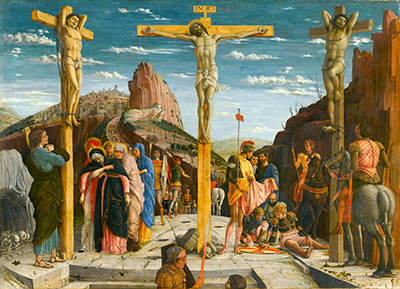The Crucifixion is a 15th-century painting by Andrea Mantegna. It is one of three panels that decorate the predella of the San Zeno altarpiece in Verona, Italy. The picture is on display in the Louvre in Paris.
In the mid-15th century, Abbot Gregorio Correr commissioned Andrea Mantegna to paint the predella for the altar of the Basilica di San Zeno in Verona. The predella has three panels. The Crucifixion is the centre panel of the predella. The other panels are Agony in the Garden and the Resurrection. Mantegna painted the Crucifixion between 1456 and 1459. The work shows the crucifixion of Jesus. He painted the artwork using tempera and oil on wood. It measures 76cm x 96cm.
In 1798 the French removed the Crucifixion from the San Zeno monastery and put it on display in the Louvre, Paris. The museum in Tours, France later received the other two panels of the predella. It is possible to see a copy of all three panels on the predella in the San Zeno monastery. The original panels are on display in Paris and Tours. In painting the Crucifixion, Mantegna is noted for his use of perspective. It's what makes his work exceptional. The viewer gets a sense that they are looking up at the cross. By using a dark-to-light gradient in the sky, he creates a feeling of atmospheric perspective. The sky in the painting is darker in colour at the top, while lighter at the horizon. As a result, the landscape appears to merge with the light blue sky.
The use of perspective also comes through in the painting's composition. Jesus’ cross is located in the centre of the picture. The crosses situated on either side are turned slightly inwards. This creates diagonal lines that lead into the distance to create a vanishing point below the feet of Jesus. Likewise, the cracks in the floor of the picture all run diagonally. It gives the viewer a feeling of depth when looking at the picture. Mantegna’s main legacy is that his works introduce us to the strong use of perspective in art. Generally, he is seen as being a leading influence on painting in northern Italy. See also Crucifixion by Piero della Francesca and also Giovanni Bellini's version.




